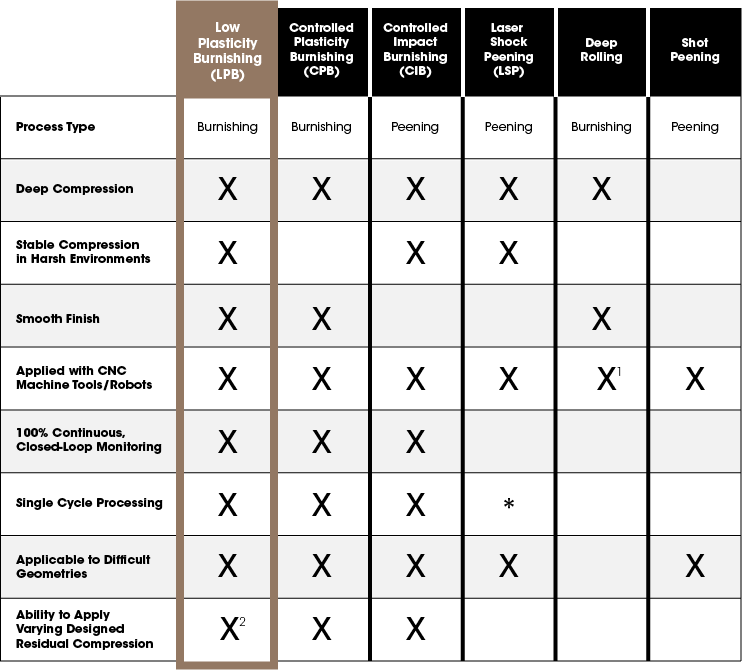Low Plasticity Burnishing-LPB®
Low Plasticity Burnishing (LPB®) is Lambda Technologies Group’s most popular method of introducing designed compressive residual stresses to improve component performance and extend component life.
LPB has a long history of successfully mitigating failure mechanisms in metallic components, including metal fatigue,stress corrosion cracking (SCC), pitting, fretting, and foreign object damage (FOD), among others.
Low Plasticity Burnishing technology has received the R&D 100 Award for revolutionary ideas in science and technology, the John P. Davis Award from the International Gas Turbine Institute (IGTI), and the NASA Hallmark of Success award.
Process Type
LPB is a mechanical process that imparts a designed residual stress field into the surface of components to produce a deep, stable layer of beneficial residual compression. The depth, magnitude and distribution of the compression are designed specifically for each component and application, producing minimal cold work. Learn how our Process Design works.
Depth of Compression
LPB can sculpt designed levels of compression onto a component surface ranging from a few thousandths of an inch (comparable to shot peening) to over a full centimeter. Through-thickness compression on thin areas, like blade edges, is also possible with LPB.
LPB can be:
- Used in both wet and dry applications
- Applied on surfaces with complex shapes and geometries
- Performed with conventional CNC machine tools or robots
- Implemented during initial manufacturing or during maintenance/repair operations
- Applied on any component made of metals and alloys
- Used for improving component performance without changing either the material or design
Damage mechanisms that can be mitigated by LPB include, but are not limited to:
- Corrosion Fatigue
- Foreign Object Damage (FOD)
- Fretting
- High Cycle Fatigue
- Pitting
- Stress Concentration
- Stress Corrosion Cracking (SCC)
- Tension in Welds
Compare LPB to Other Surface Treatments
Click for more information on alternative surface treatment methods such as laser shock peening, deep rolling, and shot peening.
* Requires multiple passes to achieve full coverage.
1 Generally applied using lathes
2 Tailored to applied stresses with high resolution
How is LPB different from other surface treatments?
-
Minimal cold work: LPB imparts a minimal amount of cold work, so the beneficial compressive layer is more stable at elevated temperatures and not prone to mechanical relaxation in the event of a momentary tensile overload.
-
No surface damage: LPB causes no surface damage, so there is no finish machining/grinding required after processing to eliminate dents and surface damage. LPB leaves an improved, mirror-like surface finish on all processed parts. Metallographic examination reveals no damage to the grain structure following treatment.
-
Closed-loop process: LPB features 100% continuous closed-loop monitoring and control with typical Six Sigma statistical process control, ensuring a uniform, repeatable production process. It is easily performed on the shop-room floor, requiring no specialized or remote facilities, and it requires minimal operator intervention, allowing fewer chances for human error.
-
Only one processing cycle: LPB requires only one processing cycle to achieve full depth of compression, which can mean faster processing time and lower operational costs. LPB also can reduce inspection requirements, achieving maximum safety at a minimal cost.


